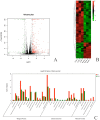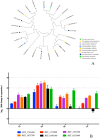Transcriptome-Based Analysis Reveals a Crucial Role of BxGPCR17454 in Low Temperature Response of Pine Wood Nematode (Bursaphelenchus xylophilus)
- PMID: 31197083
- PMCID: PMC6628231
- DOI: 10.3390/ijms20122898
Transcriptome-Based Analysis Reveals a Crucial Role of BxGPCR17454 in Low Temperature Response of Pine Wood Nematode (Bursaphelenchus xylophilus)
Abstract
Background: The causal agent of pine wilt disease is the pine wood nematode (PWN) (Bursaphelenchus xylophilus), whose ability to adapt different ecological niches is a crucial determinant of their invasion to colder regions. To discover the molecular mechanism of low temperature response mechanism, we attempted to study the molecular response patterns under low temperature from B. xylophilus with a comprehensive RNA sequencing analysis and validated the differentially expressed genes (DEGs) with quantitative real-time polymerase chain reaction (qRT-PCR). Bioinformatic software was utilized to isolate and identify the low-temperature-related BxGPCR genes. Transcript abundance of six low-temperature-related BxGPCR genes and function of one of the BxGPCR genes are studied by qRT-PCR and RNA interference.
Results: The results showed that we detected 432 DEGs through RNA sequencing between low-temperature-treated and ambient-temperature-treated groups nematodes. The transcript level of 6 low-temperature-related BxGPCR genes increased at low temperature. And, the survival rates of BxGPCR17454 silenced B. xylophilus revealed a significant decrease at low temperature.
Conclusion: in conclusion, this transcriptome-based study revealed a crucial role of BxGPCR17454 in low temperature response process of pine wood nematode. These discoveries would assist the development of management and methods for efficient control of this devastating pine tree pest.
Keywords: Bursaphelenchus xylophilus; GPCR; RNAi; low temperature; pine wilt disease; transcriptome.
Conflict of interest statement
The authors declare no conflict of interest.
Figures





Similar articles
-
Expression Profiling of Autophagy Genes BxATG1 and BxATG8 under Biotic and Abiotic Stresses in Pine Wood Nematode Bursaphelenchus xylophilus.Int J Mol Sci. 2017 Dec 6;18(12):2639. doi: 10.3390/ijms18122639. Int J Mol Sci. 2017. PMID: 29211016 Free PMC article.
-
Influence of Bxpel1 Gene Silencing by dsRNA Interference on the Development and Pathogenicity of the Pine Wood Nematode, Bursaphelenchus xylophilus.Int J Mol Sci. 2016 Jan 19;17(1):125. doi: 10.3390/ijms17010125. Int J Mol Sci. 2016. PMID: 26797602 Free PMC article.
-
Molecular characterization and development of real-time PCR assay for pine-wood nematode Bursaphelenchus xylophilus (Nematoda: Parasitaphelenchidae).PLoS One. 2013 Nov 11;8(11):e78804. doi: 10.1371/journal.pone.0078804. eCollection 2013. PLoS One. 2013. PMID: 24244367 Free PMC article.
-
[Ecological relationships between Bursaphelenchus xylophilus and its companion microorganisms].Ying Yong Sheng Tai Xue Bao. 2011 Mar;22(3):810-5. Ying Yong Sheng Tai Xue Bao. 2011. PMID: 21657042 Review. Chinese.
-
Pine wood nematode, Bursaphelenchus xylophilus.Annu Rev Phytopathol. 2013;51:61-83. doi: 10.1146/annurev-phyto-081211-172910. Epub 2013 May 6. Annu Rev Phytopathol. 2013. PMID: 23663004 Review.
Cited by
-
Trehalose 6-phosphate synthase gene rdtps1 contributes to thermal acclimation in Rhyzopertha dominica.BMC Genomics. 2024 Feb 13;25(1):172. doi: 10.1186/s12864-024-10028-4. BMC Genomics. 2024. PMID: 38350857 Free PMC article.
-
Cytochrome P450 metabolism mediates low-temperature resistance in pinewood nematode.FEBS Open Bio. 2020 Jun;10(6):1171-1179. doi: 10.1002/2211-5463.12871. Epub 2020 May 22. FEBS Open Bio. 2020. PMID: 32348629 Free PMC article.
-
Transcriptome analysis of the response to low temperature acclimation in Calliptamus italicus eggs.BMC Genomics. 2022 Jul 1;23(1):482. doi: 10.1186/s12864-022-08705-3. BMC Genomics. 2022. PMID: 35778687 Free PMC article.
-
Transcriptome Profile Changes Associated With Heat Shock Reaction in the Entomopathogenic Nematode, Steinernema carpocapsae.Front Physiol. 2020 Jul 10;11:721. doi: 10.3389/fphys.2020.00721. eCollection 2020. Front Physiol. 2020. PMID: 32754045 Free PMC article.
-
Effect of Associated Bacteria GD1 on the Low-Temperature Adaptability of Bursaphelenchus xylophilus Based on RNA-Seq and RNAi.Microorganisms. 2023 Feb 8;11(2):430. doi: 10.3390/microorganisms11020430. Microorganisms. 2023. PMID: 36838395 Free PMC article.
References
-
- Mota M.M., Futai K., Vieira P. Pine Wilt Disease and The Pinewood Nematode, Bursaphelenchus xylophilus. In: Ciancio A., Mukerji K., editors. Integrated Management of Fruit Crops Nematodes. Volume 4. Springer; Dordrecht, The Netherlands: 2009. pp. 253–274.
-
- Gruffudd H.R., Jenkins T.A.R., Evans H.F. Using an evapo-transpiration model (ETpN) to predict the risk and expression of symptoms of pine wilt disease (PWD) across Europe. Boil. Invasions. 2016;18:2823–2840. doi: 10.1007/s10530-016-1173-7. - DOI
-
- Yu Z., Li S., Zhou Y., Zhou R., Wang Y. Spatial estimation and prediction of suitable distribution of Bursaphelenchus xylophilus with different warming modes in China. J. Northeast For. Univ. 2018;46:85–91.
-
- Feng Y.M., Zhang H.J., Lü Q., Liang J., Zhang X.Y. Quantification of suitability distribution region of Bursaphelenchus xylophilus in China. Scientia Silvae Sinicae. 2009;45:65–71. doi: 10.11707/j.1001-7488.20090211. - DOI
MeSH terms
Substances
Grants and funding
LinkOut - more resources
Full Text Sources

